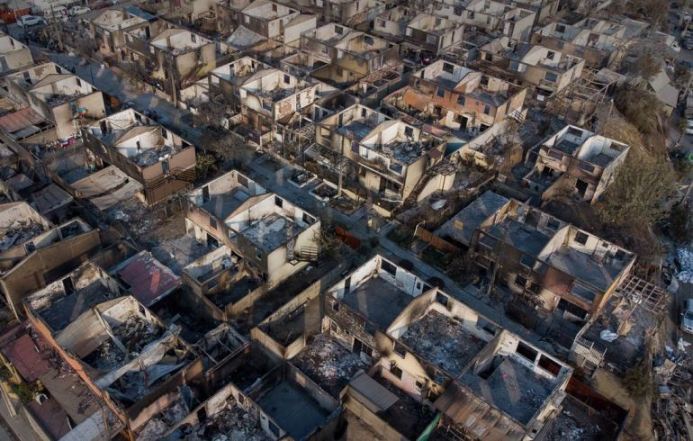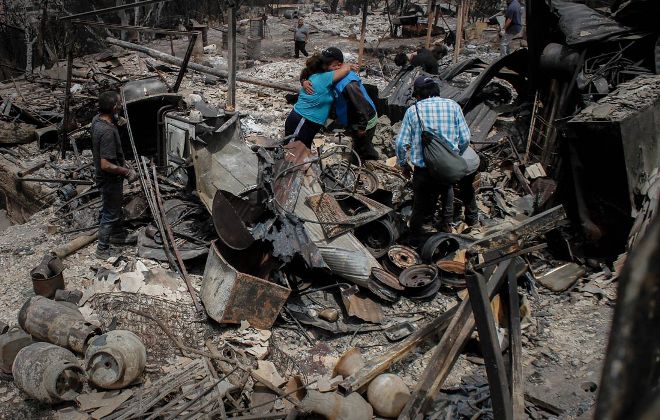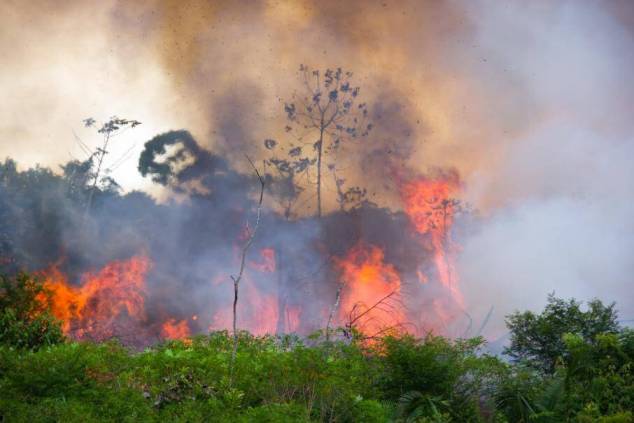The fires in Colombia this month are unusual for a country where people are more accustomed to heavy rain and landslides than fires and ash. They have been linked to high temperatures and drought, exacerbated by the climate phenomenon known as El Niño. In Brazil, fires have destroyed large swaths of rainforest in recent years. Chile has declared two days of national mourning for those killed in the devastating forest fires that engulfed the Valparaiso region. Already 112 people have become victims of the disaster.
Chile has declared two days of national mourning for those killed in the devastating forest fires that engulfed the Valparaiso region. 131 people have already become victims of the disaster. According to Monsalve, in the resort town of Viña del Mar in Valparaiso and its surroundings, 200 people are missing. The deputy head of the Ministry of Internal Affairs said that over the past few days, 165 fires have broken out in Chile, 40 of them cannot be contained. Another 112 fires are under control, four fires have been extinguished.

Monsalve added that the fires damaged or destroyed houses where about 40 thousand people live. Fires have destroyed or damaged more than 14,000 homes in Chile. Authorities imposed a curfew in Viña del Mar and the neighboring towns of Quilpue and Villa Alemana to ease the work of firefighters and rescue workers and to curb looting. The deputy head of the Ministry of Internal Affairs of Chile explained that the simultaneous occurrence of several fires may indicate that they were started deliberately.
Valparaiso Gov. Rodrigo Mundaca also said he believes some of the fires in the region may have been the result of arson. “Fires started simultaneously in four places. We will have to work carefully to find those responsible,” he said. The day before, Chilean President Gabriel Borich called on residents of the country to assist fire services and announced the introduction of a state of emergency in Valparaiso. Borich also announced two days of national mourning for the victims starting Monday.
Chilean President Gabriel Boric called the forest fires that engulfed the central part of the country the biggest national tragedy since the devastating 2010 earthquake. At the end of February 2010, a magnitude 8.8 earthquake and subsequent tsunami killed more than 500 people in Chile.

Last January in Colombia was the hottest in three decades. As a result, instead of the usual heavy rains and mudflows, there are fires and ashes. Dozens of fires across the country. Thick smog periodically blankets the sky, and residents are ordered to wear masks and limit traffic due to poor air quality and limited visibility. The president declared a national disaster in the country and requested international assistance in fighting the fires, which, according to him, could spread beyond the Andes and break out on the Pacific coast and in the Amazon, The New York Times shares.
In January, the temperature reached a record +43°. Forests, savannas and the usually damp highlands known as Páramos have dried up, turning parts of the country into a tinderbox. Officials say more fires are likely before the rainy season begins in April. Fires also broke out in neighboring Venezuela and Ecuador. High temperatures and droughts have been exacerbated by the El Niño phenomenon that occurs in the tropical Pacific Ocean. However, the source of most fires is human error.
Colombia, a normally wet country, is suffering from severe forest fires. Firefighters, many of them volunteers, have faced dozens of fires this month amid high temperatures. These conditions are believed by many meteorologists to be linked to climate change. The president declared a national disaster and asked for international help to fight the fires, which he said could spread beyond the Andes to the Pacific coast and the Amazon.

The fires in Colombia this month are unusual for a country where people are more accustomed to heavy rain and landslides than fires and ash. They have been linked to high temperatures and drought, exacerbated by the climate phenomenon known as El Niño. Ricardo Lozano, a geologist and former Colombian environment minister, said El Niño is a natural phenomenon that occurs in cycles, but with climate change, “these events are becoming more and more intense, and more and more extreme.”
In recent years, fires in Brazil have destroyed large swaths of rainforest. Over 38 years, 185.7 million hectares have been damaged by fires in Brazil – an area equal to the area of Colombia and Chile combined, or 21.8% of the country’s territory, the country’s authorities calculated, reports Agencia Brazil.
“These time series of fire data allow us to understand the influence of climate and human actions on fires and wildfires,” said Ane Alencar, coordinator of MapBiomas Fogo and scientific director of the Amazon IPAM Research Institute. Using images from three Landsat satellites, experts tracked the effects of fires in all types of land use in Brazil. The Cerrado and Amazon were the most affected biomes, with 86% of the area burned.

In early November 2023, Brazilian firefighters celebrated the end of the fire season, but the fire broke out again. It destroyed most of the natural area of the Pantanal, reports the Associated Press. Fires fueled by unusually dry and hot weather destroyed nearly 770,000 hectares of the world’s largest tropical wetland in the first two weeks of November, the Federal University of Rio de Janeiro said on Monday. This represents 65% of the damage caused by fires in the region this year.
In the first 17 days of November, 3,380 fires were recorded in Brazilian wetlands, far exceeding previous fire season records dating back to 1998. According to the World Wildlife Fund, the natural area is home to thousands of species of plants and animals that are at risk of dying if the fire is not brought under control. Experts are especially worried about the jaguar population.




